|
(11) | EP 0 178 751 B1 |
| (12) | EUROPEAN PATENT SPECIFICATION |
|
|
| (54) |
Silicone elastomers with good adhesion Silikonelastomere mit guter Haftung Elastomères de silicones avec un bon pouvoir adhésif |
|
|
|||||||||||||||||||||||||||||||
| Note: Within nine months from the publication of the mention of the grant of the European patent, any person may give notice to the European Patent Office of opposition to the European patent granted. Notice of opposition shall be filed in a written reasoned statement. It shall not be deemed to have been filed until the opposition fee has been paid. (Art. 99(1) European Patent Convention). |
[0001] This invention relates to silicone elastomer-forming compositions having improved substrate adhesion in the cured state and also relates to a composition for promoting such improved adhesion.
Prior art
[0002] Silicone elastomer-forming compositions which are capable of curing to elastomers at normal ambient temperatures are now well known in the art. Such compositions are available as two types. One type comprises compositions which are supplied in a single package and which cure on exposure to the moisture in the atmosphere. The other type is supplied as a two package (or two part) composition which cures when the contents of the two packages are mixed in the appropriate proportions. Typically one package of the latter type of composition contains a hydroxyl-terminated polydiorganosiloxane and one or more fillers. The other package contains a silane or siloxane having on average more than two silicon-bonded alkoxy or alkoxyalkoxy groups per molecule and a curing catalyst. Other additives e.g. additional fillers, plasticisers and pigments may be present in either or both packages. Such two-package compositions are described in, for example, British Patents 841 825, 844128, 867511 and 938399.
[0003] For certain applications of the two part compositions it is often desired to improve the adhesion of the cured elastomer to a substrate, for example glass, aluminium or concrete. It is known that an improvement in adhesion can be realised by incorporating in the composition a silane or siloxane having amino-substituted organic groups in the molecule. One such adhesion promoter is aminopropyltriethoxysilane. Another known adhesion promoter for the two part compositions is glycidoxypropyltrimethoxysilane. Although both silanes provide good adhesion to a wide range of substrates it has been found that the adhesive bond degrades rapidly under wet conditions.
[0004] U.S. Patent Specification 4,252,933 describes self-bonding polyorganosiloxane coating compositions comprising a hydroxyl end-blocked polydiorganosiloxane and a combination of a certain epoxy-functional polysiloxane with an amino-functional silicone compound.
[0005] U.S. Patent Specification 4,412,035 describes the use of a reaction product of a certain aminosilane and a certain epoxysilane in a silicone emulsion composition.
[0006] In Chemical Abstract 91:212295d there is described a composition for adhesives, comprising vinyl-terminated dimethylpolysiloxanes, methylhydrogen polysiloxanes and the reaction product of epoxides with aminosilanes and/or aminosiloxanes.
Summary of the invention
[0007] We have now surprisingly discovered that improved adhesion under wet conditions of the said two-package compositions can be realised if there are incorporated into the said compositions both an amino-substituted silane and a silane containing an epoxy group.
[0008] Accordingly this invention provides a composition comprising the product obtained by mixing (A) 100 parts by weight of a silanol-terminated polydiorganosiloxane, (B) 1 to 15 parts by weight of a crosslinking agent for (A) which is a silicon compound having in the molecule at least 3 silicon-bonded groups selected from alkoxy and alkoxyalkoxy groups having less than 6 carbon atoms, (C) 0.1 to 10 parts of a metal or organometal salt of a carboxylic acid, (D) a silane of the general formula
wherein R represents a hydrogen atom, an alkyl group having from 1 to 4 inclusive carbon atoms or an aliphatic hydrocarbon group attached to the nitrogen atom through a carbon to nitrogen bond and containing at least one amino group, R' represents an alkylene group having from 3 to 6 inclusive carbon atoms, X represents a monovalent hydrocarbon group having from 1 to 6 inclusive carbon atoms, Y represents an alkyl or alkoxyalkyl group having less than 6 carbon atoms and a has a value of 0 or 1, and (E) a silane of the general formula
wherein Z represents an organic group composed of carbon, hydrogen and oxygen having therein at least one group of the formula
L represents an alkyl group having from 1 to 4 inclusive carbon atoms, or a phenyl group, M represents an alkyl or an alkoxyalkyl group having less than 6 carbon atoms and b has a value of 0 or 1, (D) and (E) being employed in a ratio of from 0.1 to 3 moles of (D) per mole of (E) and in a combined weight of from 0.88 to 4.5 parts.
[0009] The invention also provides a process for the preparation of an elastomer which comprises mixing components (A) to (E) as hereinabove defined and thereafter curing the composition.
[0010] In the polydiorganosiloxanes (A) the organic substituents can be lower aliphatic hydrocarbon groups e.g. methyl, ethyl, propyl or vinyl, phenyl or fluorinated hydrocarbon groups e.g. 3.3.3-trifluoropropyl. Preferably at least 50 percent of the substituents are methyl with any remaining groups being selected from phenyl and vinyl; the most preferred polydiorganosiloxanes being the polydimethylsiloxanes. The viscosity of the polydiorganosiloxane is not critical and will depend upon various factors including the intended application of the end-product. Generally polydiorganosiloxanes having viscosity within the range from 500 to 100,000 mPa - s at 25°C can be employed, the preferred polydiorganosiloxanes being those having a viscosity in the range from 1000 to 75000 mPa - s at 25°C. Polydiorganosiloxanes (A) are well known substances. They are widely employed in the manufacture of room temperature vulcanising silicone elastomers and may be represented by the general formula
wherein each R" represents an organic substituent e.g. methyl, and x is an integer, preferably having an average value of from about 300 to about 1500.
[0011] As the crosslinking agent (B) there may be employed certain silicon compounds, or mixtures thereof, having in the molecule at least three silicon-bonded alkoxy or alkoxyalkoxy groups. The silicon compound may be a silane or a siloxane. Illustrative of such silicon compounds are alkyl orthosilicates e.g. ethyl orthosilicate and propyl orthosilicate, alkyl polysilicates e.g. ethyl polysilicate and n-propyl polysilicate, monoorganotrialkoxysilanes e.g. methyl trimethoxysilane, ethyl trimethoxysilane, methyl tri n-propoxysilane, butyl triethoxysilane and phenyl trimethoxysilane. Other silicon compounds which can be employed include Si(OCH,CH20CH3)4 and methylpolysiloxanes containing silicon-bonded alkoxy groups e.g. methoxy or ethoxy groups. In general the preferred crosslinking agents (B) are silanes having 3 or 4 alkoxy groups attached to the silicon atom or the partial hydrolysis and condensation products of such silanes. The silicon compound (B) is employed in a proportion of from 1 to 15 parts by weight per 100 parts by weight of the silanol-terminated polydiorganosiloxane (A).
[0012] Component (C) of the compositions of this invention is a curing catalyst and comprises a metal or organometal salt of a carboxylic acid. The metal may be e.g. zinc, cobalt or lead but is preferably tin. Examples of salts (C) are zinc naphthenate, lead octoate, stannous octoate, dibutyltin dilaurate, dibutyltin dioctoate and dibutyltin diversatate. The curing catalyst (C) is employed in a proportion of from 0.1 to 10 percent by weight based on the weight of (A).
[0013] Compositions comprising (A), (B) and (C) are well-known in the organosilicon art and include commercially available materials. Such compositions have been described in, for example, British Patents 841 825, 844 128 and 938 399.
[0014] Component (D) of the compositions of this invention comprises one or more silanes having in the molecule silicon-bonded hydrocarbonoxy groups and a silicon-bonded hydrocarbon group (preferably having no more than 12 carbon atoms) containing at least one amino group. In the general formula of the silanes (D) the substituent R may be hydrogen, lower alkyl or an aliphatic group containing at least one amino group. R may therefore represent for example H, methyl, ethyl, propyl, the group -(CH2CH2NH),H wherein z is an integer, preferably 1 or 2, or the group H2NQ- wherein Q is a divalent hydrocarbon group e.g. -CH . CH3CH2-, -(CH2)4- or ―(CH2)5―. The substituent Y may be for example, methyl, ethyl or methoxyethyl. Preferred as component (D) are compounds represented by the formulae
wherein R' represents an alkylene group having 3 or 4 carbon atoms e.g.―(CH2)3―or―CH2CH · CH3CHz-and each Y represents methyl, ethyl or methoxyethyl.
[0015] As component (E) of the compositions there are employed one or more silanes having silicon-bonded hydrocarbonoxy groups and a silicon-bonded organic group having therein an epoxy group. In the general formula of the silanes (E) the substituent Z may be any epoxy-containing organic group composed of carbon, hydrogen and oxygen. Examples of such substituents are those represented by the general formula
wherein Q' represents a divalent group e.g. ―CH2CH2―, -(CH2)3-, ―CH2CH · CH3CH2-, phenylene, cvclohexvlene.
The group M may be for example methyl, ethyl or methoxyethyl. Preferably Z represents the group
and M is methyl or ethyl.
[0016] Improved adhesion of the cured elastomer to glass, aluminium and concrete under wet conditions has been observed when the molar ratio of the amino silane (D) to the epoxy silane (E) present in the composition lies in the range from 0.1:1 to 3:1. However, optimum results appear to be obtained when the ratio of (D) to (E) is in the range from 0.4:1 to 0.7:1. The degree of improved adhesion of the cured elastomer under wet conditions is dependent to some extent on the proportion of (D) and (E) incorporated into the curable composition. Best results are obtained when the total weight of (D) and (E) employed is from 1.5 to 4.5 percent based on the weight of the polydiorganosiloxane (A). More than 4.5 percent by weight may be employed but no further improvement in adhesion is believed to accrue at such higher levels of addition.
[0017] The compositions of this invention may be prepared by simply mixing the components (A) to (E) in the desired proportions. However, compositions of the type comprising (A), (B) and (C) are normally supplied as a two package product wherein the catalyst (C) is packaged separately from the polydiorganosiloxane (A). The crosslinker (B) may be mixed with (A) or with (C) or with both. In use the contents of the packages are mixed and curing commences. Silane (E) may therefore be packaged as a mixture with the polydiorganosiloxane (A) and silane (D) may be present in admixture with the catalyst. Where storage stability of the compositions is required it is desirable that the aminosilane (D) should not be mixed with (A). However, it has been found that the best results are obtained when (D) and (E) are brought together prior to mixing with the remaining components of the elastomer-forming composition. Components (D) and (E) may therefore be mixed together and packaged separately from the two packages containing (A), (B) and (C). Preferably, however, (D) and (E) are packaged as a mixture with the catalyst (C) and the elastomer-forming composition supplied as a two-package product. The reason for the improved adhesion resulting from the combination of (D) and (E) is not known. It is believed, however, that the silanes react together when mixed, and that it is the reaction product which contributes to the improved adhesion under wet conditions. If desired the mixture may be heated (e.g. to 25-70°C) to increase the speed or degree of reaction. However, such a heating step is not essential.
[0018] In addition to components (A) to (E) defined hereinabove the compositions of this invention may contain any of the other ingredients normally present in silicone elastomer-forming compositions. In particular any of a variety of fillers may be incorporated, for example silica aerogel, diatomaceous earth, crushed quartz, zinc oxide, titanium dioxide, calcium carbonate, iron oxide and carbon black. Other ingredients which may also be present are pigments, heat stability additives and polydiorganosiloxanes, e.g. polydimethylsiloxanes having triorganosilyl units e.g. trimethylsilyl units at one or both ends of the molecule.
[0019] When cured the compositions of this invention exhibit good adhesion, particularly under wet conditions to substrates such as glass, aluminium, concrete, and plastics e.g. polycarbonates, polyester and ABS. They are therefore particularly adapted for use in applications where such adhesion is required, for example as sealants for glazed units and concrete structures. It has been observed that in addition to improved adhesion the cured elastomer exhibits reduced water pick-up when compared with elastomers employing the known aminosilane additives.
[0020] The following examples in which the percentages are expressed by weight illustrate the invention.
Example 1
[0022] To Part B was added 5.0% of NHZ(CHZ)3Si(OCZHS)3 and 8.3% of
representing a molar ratio of amino silane to epoxy silane of 0.65:1. This composition was allowed to stand at room temperature for 24 hours.
[0023] Parts A and B were then thoroughly mixed together in a weight ratio of 10 parts A to 1 part B and the resulting composition employed to make 'H-pieces' for testing according to SNJF (France) Test Method 85-504. The 'H-pieces' were fabricated employing parallel plates (5 cmx5 cm) of glass, milled aluminium and concrete respectively, a rectangular bead of the cured elastomer forming the crossmember between the plates.
[0024] The concrete 'H-pieces' were placed in water at 50°C for 3 days and the plates pulled apart at a speed of 50 mm per minute, the pulling force at which failure of the sample occurred being recorded. The failed sample was also inspected to ascertain the mode of failure. Cohesive failure is recorded when the elastomer fails internally. Adhesive failure occurs when the elastomer separates from the substrate without tearing. Cohesive failure indicates that the adhesive bond between the elastomer and the substrate is stronger than the elastomer itself. Boundary failure is a condition in which separation is not clearly the result of adhesive failure but takes place close to the elastomer/substrate interface. When only cohesive failure is specified in the data herein any remaining percentage failure is adhesive.
[0026] When test pieces of glass and aluminium were immersed in water at 50°C and 90°C for the periods indicated and the pulled apart as described above the test results were as follows:
Example 2
[0027] In this example the sealant composition and the catalyst/adhesion promoter were prepared as in Example 1 except that the mixture of gamma-aminopropyltriethoxysilane and gamma-glycidoxypropyltri- methoxy silane were combined in a ratio of 0.85:1. The mixture was added to part B in an amount sufficient to provide 5.9% amino silane and 7.4% epoxy silane and "H-pieces" were made using glass substrates. The performance of this adhesion promoter in the sealant in glass "H-pieces" is shown in Table 2:
[0028] Compared with the results shown in Table 1b, the results in Table 2 show the adhesion promoter of Example 2, to be less effective in the elastomer-forming composition under test.
Example 3
[0029] In this example the sealant composition and the catalyst/adhesion promoter were prepared as in Example 1 except that the silanes were incorporated into Part B in an amount sufficient to provide 2.9% of epoxy silane and 1.7% of amino silane. The performance of this adhesion promoter in the sealant in glass "H-pieces" is shown in Table 3.
Example 4
[0030] In this example the sealant and the adhesion promoter were prepared as in Example 1 except that the mixture of silanes was added in an amount sufficient to provide 21.4% of epoxy silane and 13% of amino silane based on Part B. The results obtained from tests on glass "H-pieces" are shown in Table 4.
Example 5
[0031] In this example, the sealant and the adhesion promoter were prepared as in Example 1 except that N-(trimethoxysilylpropyl)ethylenediamine was used in place of gamma-aminopropyltrimethoxysilane. The amino/epoxy-functional silane molar ratio was 0.45/1 and this adhesion promoter was added to Part B in an amount sufficient to provide 9.4% of epoxy silane and 4.2% of amino silane (based on the weight of Part B). The sealant was tested on glass and milled aluminium as described in Example 1, and the results are shown in Table 5.
[0032] By comparing the results shown in Table 5 with those shown in Table 1b it can be seen that the adhesion promoter of this example provides adhesion of the sealant to glass and aluminium substrates which is comparable to that obtained with the silane mixture used in Example 1.
Example 6
[0033] In this example, the sealant and adhesion promoter were made as in Example 5 except that the ratio of diamino to epoxyfunctional silane was changed to 0.25, sufficient of the mixture of silanes being added to Part B to provide 11 % of the epoxy silane and 2.7% of the amino silane. The resulting sealant was tested for adhesion to glass and to milled aluminium according to the procedure described in Example 1. The results are shown in Table 6.
Example 7
[0034] In this comparative example the sealant and the adhesion promoter are prepared as in Example 1 except that the epoxy silane was omitted and only the amino silane was employed as the adhesion promoter. It was added to part B in proportion of 12.8% by weight based on the weight of Part B. The resulting sealant was formed into "H-pieces" using concrete, glass and milled aluminium substrates and tested for adhesion as described in Example 1. The results are shown in Table 7.
[0035] A comparison of the results shown in Table 7 with those shown in Tables 1a and 1b give a clear indication of the improvement in adhesion shown by the adhesion promoter of the present invention. A comparison of the results of Table 7 with those shown in Tables 2 and 3 indicates the improved performance of the adhesion promoter of the present invention over the prior art adhesion promoter of Example 7 even when the adhesion promoter of the present invention is used in a non-preferred ratio of amino silane to epoxy silane (as in Example 2) or in a non-preferred concentration (as in Example 3).
Example 8
[0036] In this comparative example the procedure of Example 1 was repeated except that the amino silane was omitted and only the epoxy silane was used as the adhesion promoter. It was added to Part B in a proportion of 13.7% by weight based on the weight of Part B. "H-pieces" made from the resulting sealant on glass and aluminium substrates were subjected to the 50°C and 90°C water tests described above. The results are shown in Table 8.
[0037] A comparison of the results shown in Table 8 with those shown in Table 1 indicates the dramatic improvement in the performance of the adhesion promoter of the present invention over the performance obtained by using only an epoxyfunctional silane as an adhesion promoter.
Example 9
[0038] In this comparative example the procedure of Example 1 was repeated except that the amino silane/epoxy silane molar ratio was 2.5. The amino silane and epoxy silane were added in proportions of 9.2% and 3.9% respectively based on the weight of Part B. Sealant made according to this example was tested on glass and milled aluminium substrates according to the procedure of Example 1. The results are shown in Table 9.
[0039] By comparing the results shown in Table 9 with those shown in Table 7, it is seen that the adhesion promoter made of the silane of Example 1 shows no improvement in glass adhesion, when the components are combined at a 2.5 aminofunctional silane/epoxyfunctional silane molar ratio, but that some improvement in aluminium adhesion is evident.
Example 10
[0040] In this example the sealant and the adhesion promoter were prepared according to Example 1 except that the amino silane/epoxy silane ratio was 0.4/1. The amino silane and epoxy silane were added in proportions of 3.7% and 9.8% respectively based on Part B. "H-pieces" were made using the resulting sealant with glass and milled aluminium substrates.
[0041] The "H-pieces" were subjected to the tests described in Example 1 and the test results'are shown in Table 10.
[0042] A comparison of the results shown in Table 10 with those shown in Tables 7 and 8 indicate that an amino silane/epoxy silane ratio of 0.4 achieves better adhesion of the sealant to glass and milled aluminium substrates than does either of the silanes alone when added at the same concentration.
Example 11
[0043] In this comparative example a two-part silicone sealant composition is made by mixing as Part A 50% of 50,000 mPa - s silanol-terminated polydimethylsiloxane and 50% of 5 pm ground quartz filler and by mixing as Part B 20% ethylorthosilicate, 13% of the amino silane adhesion promoter employed in Example 7; 0.25% dibutyltindilaurate and the balance to 100% of trimethylsilyl end-stopped polydimethylsiloxane having a viscosity of 12,500 mPa - s at 25°C. Parts A and B were mixed in a ratio of 10 parts A to one part B and the resulting composition was cured to form "H-pieces" on glass substrates as in Example 1. The resulting "H-pieces" were subjected to a 90°C water test and the results are shown in Table 11.
Example 12
[0044] In this example a silicone sealant was prepared as in Example 11 except that the adhesion promoter added to Part B was a mixture of the amino silane and epoxy silane described in Example 1 combined at amino silane/epoxy silane molar ratio of 0.65/1 and added to Part B in proportions of 8.3% epoxy silane and 5% amino silane based on the weight of Part B.
[0045] Parts A and B were mixed to form a curable silicone sealant which was cured into "H-pieces" using glass substrates. The cured "H-pieces" were subjected to 90°C water tests as in Example 11 and produced the results shown in Table 12.
Example 13
[0046] A two-part elastomer-forming composition was prepared as described in Example 1. To Part A was added 0.83% (based on weight of Part A) of the epoxy silane described in Example 1 and to Part B was added 5.0% by weight (based on the weight of Part B) of the amino silane of that Example. Parts A and B were then thoroughly mixed together in a ratio by weight of 10 parts A to 1 part of B. The composition was employed to fabricate glass substrate 'H-pieces' and the pieces tested as described in Example 1 following immersion in water at 90°C. The test results were as follows:
1. A composition comprising the product obtained by mixing (A) 100 parts by weight
of a silanol-terminated polydiorganosiloxane, (B) 1 to 15 parts by weight of a crosslinking
agent for (A) which is a silicon compound having in the molecule at least three silicon-bonded
groups selected from alkoxy and alkoxyalkoxy groups having less than 6 carbon atoms,
(C) 0.1 to 10 parts by weight of a metal or organometal salt of a carboxylic acid,
(D) a silane of the general formula
wherein R represents a hydrogen atom, an alkyl group having from 1 to 4 inclusive carbon atoms or an aliphatic hydrocarbon group attached to the nitrogen atom through a carbon to nitrogen bond and containing at least one amino group, R' represents an alkylene group having from 3 to 6 inclusive carbon atoms, X represents a monovalent hydrocarbon group having from 1 to 6 inclusive carbon atoms, Y represents an alkyl or alkoxyalkyl group having less than 6 carbon atoms and a has a value of 0 or 1, and (E) a silane of the general formula
in which Z represents an organic group composed of carbon, hydrogen and oxygen having therein at least one group of the formula
, represents an alkyl group having from 1 to 4 inclusive carbon atoms, or a phenyl group, M represents an I alkyl or an alkoxyalkyl group having less than 6 carbon atoms and b has a value of 0 or 1, (D) and (E) being employed in a ratio of from 0.1 to 3 moles of (D) per mole of (E), and in a combined weight of from 0.88 to 4.5 parts by weight.
2. A composition as claimed in Claim 1 wherein the cross-linking agent (B) is a silane
having 3 or 4 alkoxy groups attached to the silicon atom or is a partial hydrolysis
and condensation product of such a silane.
3. A composition as claimed in Claim 1 or Claim 2 wherein (C) is a tin or organotin
salt of a carboxylic acid.
4. A composition as claimed in any one of the preceding claims wherein (D) is a silane
of the general iformula I

wherein R' represents an alkylene group having 3 or 4 carbon atoms and each Y represents methyl, ethyl or methoxyethyl.
wherein R' represents an alkylene group having 3 or 4 carbon atoms and each Y represents methyl, ethyl or methoxyethyl.
5. A composition as claimed in any one of the preceding claims wherein the silane
(E) has the general formula

wherein M is methyl or ethyl.
wherein M is methyl or ethyl.
6. A composition as claimed in any one of the preceding claims wherein the molar ratio
of the amino silane (D) to the epoxy silane (E) is in the range from 0.4:1 to 0.7:1.
7. A composition as claimed in any one of the preceding claims wherein (D) and (E)
are employed in a total weight of from 1.5 to 4.5 percent by weight based on the weight
of (A).
8. A composition as claimed in any one of the preceding claims wherein (D) and (E)
have been mixed together prior to mixing with the remaining components of the composition.
9. A process for the preparation of an elastomer which comprises mixing (A) 100 parts
by weight of a silanol-terminated polydiorganosiloxane, (B) 1 to 15 parts by weight
of a crosslinking agent for (A) which is a silicon compound having in the molecule
at least three silicon-bonded groups selected from alkoxy and alkoxyalkoxy groups
having less than 6 carbon atoms, (C) 0.1 to 10 parts by weight of a metal or organometal
salt of a carboxylic acid, (D) a silane of the general formula

wherein R represents a hydrogen atom, an alkyl group having from 1 to 4 inclusive carbon atoms or an aliphatic hydrocarbon group attached to the nitrogen atom through a carbon to nitrogen bond and containing at least one amino group, R' represents an alkylene group having from 3 to 6 inclusive carbon atoms, X represents a monovalent hydrocarbon group having from 1 to 6 inclusive carbon atoms, Y represents an alkyl or alkoxyalkyl group having less than 6 carbon atoms and a has a value of 0 or 1, and (E) a silane of the general formula
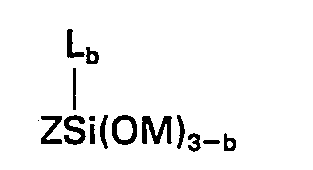
in which Z represents an organic group composed of carbon, hydrogen and oxygen having therein at least one group of the formula

L represents an alkyl group having from 1 to 4 inclusive carbon atoms, or a phenyl group, M represents an alkyl or an alkoxyalkyl group having less than 6 carbon atoms and b has a value of 0 or 1, (D) and (E) being employed in a ratio of from 0.1 to 3 moles of (D) per mole of (E) and in a combined weight of from 0.88 to 4.5 parts by weight, and thereafter curing the composition.
wherein R represents a hydrogen atom, an alkyl group having from 1 to 4 inclusive carbon atoms or an aliphatic hydrocarbon group attached to the nitrogen atom through a carbon to nitrogen bond and containing at least one amino group, R' represents an alkylene group having from 3 to 6 inclusive carbon atoms, X represents a monovalent hydrocarbon group having from 1 to 6 inclusive carbon atoms, Y represents an alkyl or alkoxyalkyl group having less than 6 carbon atoms and a has a value of 0 or 1, and (E) a silane of the general formula
in which Z represents an organic group composed of carbon, hydrogen and oxygen having therein at least one group of the formula
L represents an alkyl group having from 1 to 4 inclusive carbon atoms, or a phenyl group, M represents an alkyl or an alkoxyalkyl group having less than 6 carbon atoms and b has a value of 0 or 1, (D) and (E) being employed in a ratio of from 0.1 to 3 moles of (D) per mole of (E) and in a combined weight of from 0.88 to 4.5 parts by weight, and thereafter curing the composition.
10. An article comprising a substrate having thereon the elastomeric product of the
process of Claim 9.
1. Polydiorganosiloxanmasse, dadurch gekennzeichnet, daß es sich hierbei um das Produkt
handelt, das erhalten wird durch Vermischen von (A) 100 Gewichtsteilen eines silanolendständigen
Polydiorganosiloxans, (B) 1 bis 15 Gewichtsteilen eines Vernetzungsmittels für die
Komponente (A), bei dem es sich um eine Siliciumverbindung handelt, die im Molekül
wenigstens drei siliciumgebundene Gruppen enthält, die ausgewählt sind aus Alkoxygruppen
und Alkoxyalkoxygruppen mit weniger als 6 Kohlenstoffatomen, (C) 0,1 bis 10 Gewichtsteilen
eines Metalls oder eine Organometallsalzes einer Carbonsäure, (D) einem Silan der
allgemeinen Formel
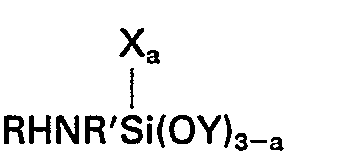
worin R ein Wasserstoffatom, eine Alkylgruppe mit 1 bis einschließlich 4 Kohlenstoffatomen oder eine aliphatische Kohlenwasserstoffgruppe ist, die an das Stickstoffatom über eine Kohlenstoff-StickstoffBindung gebunden ist und wenigstens eine Aminogruppe enthält, R' eine Alkylengruppe mit 3 bis einschließlich 6 Kohlenstoffatomen bedeutet, X eine einwertige Kohlenwasserstoffgruppe mit 1 bis einschließlich 6 Kohlenstoffatomen darstellt, Y eine Alkylgruppe oder Alkoxyalkylgruppe mit weniger als 6 Kohlenstoffatomen ist und der Index a einen Wert von 0 oder 1 hat, und (E) einem Silan der allgemeinen Formel
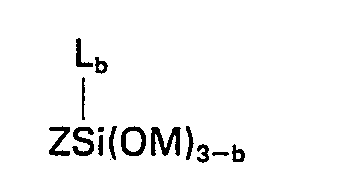
worin Z eine aus Kohlenstoff, Wasserstoff und Sauerstoff zusammengesetzte organische Gruppe bedeutet, in der wenigstens eine Gruppe der Formel
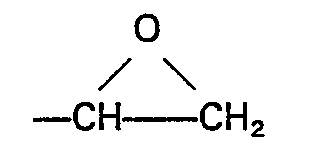
vorhanden ist, L eine Alkylgruppe mit 1 bis einschließlich 4 Kohlenstoffatomen oder eine Phenylgruppe bedeutet, M eine Alkylgruppe oder Alkoxyalkylgruppe mit weniger als 6 Kohlenstoffatomen ist und der Index b einen Wert von 0 oder 1 hat, wobei die Komponenten (D) und (E) in einem Verhältnis von 0,1 bis 3 Mol der Komponente (D) pro Mol der Komponente (E) und in einem Gesamtgewicht von 0,88 bis 4,5 Gewichtsteilen vorhanden sind.
worin R ein Wasserstoffatom, eine Alkylgruppe mit 1 bis einschließlich 4 Kohlenstoffatomen oder eine aliphatische Kohlenwasserstoffgruppe ist, die an das Stickstoffatom über eine Kohlenstoff-StickstoffBindung gebunden ist und wenigstens eine Aminogruppe enthält, R' eine Alkylengruppe mit 3 bis einschließlich 6 Kohlenstoffatomen bedeutet, X eine einwertige Kohlenwasserstoffgruppe mit 1 bis einschließlich 6 Kohlenstoffatomen darstellt, Y eine Alkylgruppe oder Alkoxyalkylgruppe mit weniger als 6 Kohlenstoffatomen ist und der Index a einen Wert von 0 oder 1 hat, und (E) einem Silan der allgemeinen Formel
worin Z eine aus Kohlenstoff, Wasserstoff und Sauerstoff zusammengesetzte organische Gruppe bedeutet, in der wenigstens eine Gruppe der Formel
vorhanden ist, L eine Alkylgruppe mit 1 bis einschließlich 4 Kohlenstoffatomen oder eine Phenylgruppe bedeutet, M eine Alkylgruppe oder Alkoxyalkylgruppe mit weniger als 6 Kohlenstoffatomen ist und der Index b einen Wert von 0 oder 1 hat, wobei die Komponenten (D) und (E) in einem Verhältnis von 0,1 bis 3 Mol der Komponente (D) pro Mol der Komponente (E) und in einem Gesamtgewicht von 0,88 bis 4,5 Gewichtsteilen vorhanden sind.
2. Masse nach Anspruch 1, dadurch gekennzeichnet, daß das Vernetzungsmittel (B) ein
Silan mit 3 oder 4 siliciumgebundenen Alkoxygruppen oder ein Teilhydrolysat und Kondensationsprodukt
eines solchen Silans ist.
3. Masse nach Anspruch 1 oder 2, dadurch gekennzeichnet, daß die Komponente (C) Zinn
oder ein Organozinnsalz einer Carbonsäure ist.
4. Masse nach irgendeinem der vorhergehenden Ansprüche, dadurch gekennzeichnet, daß
die Komponente (D) ein Silan der allgemeinen Formeln

ist, worin R' eine Alkylengruppe mit 3 oder 4 Kohlenstoffatomen bedeutet und die Substituenten Y jeweils Methyl, Ethyl oder Methoxyethyl sind.
ist, worin R' eine Alkylengruppe mit 3 oder 4 Kohlenstoffatomen bedeutet und die Substituenten Y jeweils Methyl, Ethyl oder Methoxyethyl sind.
5. Masse nach irgendeinem der vorhergehenden Ansprüche, dadurch gekennzeichnet, daß
das Silan (E) die allgemeine Formel

hat, worin M Methyl oder Ethyl bedeutet.
hat, worin M Methyl oder Ethyl bedeutet.
6. Masse nach irgendeinem der vorhergehenden Ansprüche, dadurch gekennzeichnet, daß
das Molverhältnis aus dem Aminosilan (D) und dem Epoxysilan (E) im Bereich von 0,4:1
bis 0,7:1 liegt.
7. Masse nach irgendeinem der vorhergehenden Ansprüche, dadurch gekennzeichnet, daß
die Komponenten (D) und (E) in einem Gesamtgewicht von 1,5 bis 4,5 Gewichtsprozent,
bezogen auf das Gewicht der Komponente (A), vorhanden sind.
8. Masse nach irgendeinem der vorhergehenden Ansprüche, dadurch gekennzeichnet, daß
die Komponenten (D) und (E) miteinander vermischt worden sind, bevor die restlichen
Komponenten der Masse eingemischt werden.
9. Verfahren zur Herstellung eines Elastomers, dadurch gekennzeichnet, daß (A) 100
Gewichtsteile eines silanolendständigen Polydiorganosiloxans, (B) 1 bis 15 Gewichtsteile
eines Vernetzungsmittels für die Komponente (A), bei dem es sich um eine Siliciumverbindung
handelt, die im Molekül wenigstens drei siliciumgebundene Gruppen enthält, die ausgewählt
sind aus Alkoxygruppen und Alkoxyalkoxygruppen mit weniger als 6 Kohlenstoffatomen,
(C) 0,1 bis 10 Gewichtsteile eines Metalls oder eines Organometallsalzes einer Carbonsäure,
(D) ein Silan der allgemeinen Formel
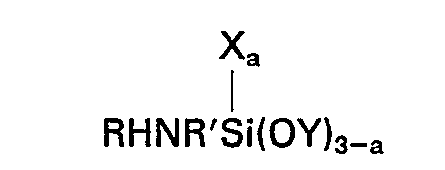
worin R ein Wasserstoffatomen, eine Alkylgruppe mit 1 bis einschließlich 4 Kohlenstoffatomen oder eine aliphatische Kohlenwasserstoffgruppe ist, die an das Stickstoffatom über eine Kohlenstoff-Sticksstoff-Bindung gebunden ist und wenigstens eine Aminogruppe enthält, R' eine Alkylengruppe mit 3 bis einschließlich 6 Kohlenstoffatomen bedeutet, X eine einwertige Kohlenwasserstoffgruppe mit 1 bis einschließlich 6 Kohlenstoffatomen darstellt, Y eine Alkylgruppe oder Alkoxyalkylgruppe mit weniger als 6 Kohlenstoffatomen ist und der Index a einen Wert von 0 oder 1 hat, und (E) ein Silan der allgemeinen Formel
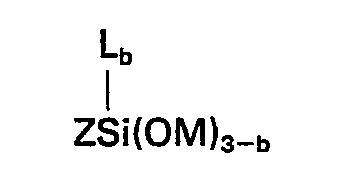
worin Z eine aus Kohlenstoff, Wasserstoff und Sauerstoff zusammengesetzte organische Gruppe bedeutet, in der wenigstens eine Gruppe der Formel
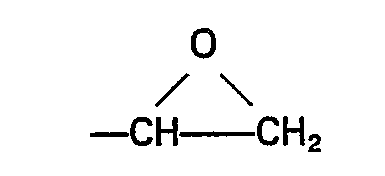
vorhanden ist, L eine Alkylgruppe mit 1 bis einschließlich 4 Kohlenstoffatomen oder eine Phenylgruppe bedetet, M eine Alkylgruppe oder Alkoxyalkylgruppe mit weniger als 6 Kohlenstoffatomen ist und der Index b einen Wert von 0 oder 1 hat, wobei die Komponenten (D) und (E) in einem Verhältnis von 0,1 bis 3 Mol der Komponente (D) pro Mol der Komponente (E) und in einem Gesamtgewicht von 0,88 bis 4,5 Gewichtsteilen angewandt werden, vermischt werden und die so erhaltene Masse dann gehärtet wird.
worin R ein Wasserstoffatomen, eine Alkylgruppe mit 1 bis einschließlich 4 Kohlenstoffatomen oder eine aliphatische Kohlenwasserstoffgruppe ist, die an das Stickstoffatom über eine Kohlenstoff-Sticksstoff-Bindung gebunden ist und wenigstens eine Aminogruppe enthält, R' eine Alkylengruppe mit 3 bis einschließlich 6 Kohlenstoffatomen bedeutet, X eine einwertige Kohlenwasserstoffgruppe mit 1 bis einschließlich 6 Kohlenstoffatomen darstellt, Y eine Alkylgruppe oder Alkoxyalkylgruppe mit weniger als 6 Kohlenstoffatomen ist und der Index a einen Wert von 0 oder 1 hat, und (E) ein Silan der allgemeinen Formel
worin Z eine aus Kohlenstoff, Wasserstoff und Sauerstoff zusammengesetzte organische Gruppe bedeutet, in der wenigstens eine Gruppe der Formel
vorhanden ist, L eine Alkylgruppe mit 1 bis einschließlich 4 Kohlenstoffatomen oder eine Phenylgruppe bedetet, M eine Alkylgruppe oder Alkoxyalkylgruppe mit weniger als 6 Kohlenstoffatomen ist und der Index b einen Wert von 0 oder 1 hat, wobei die Komponenten (D) und (E) in einem Verhältnis von 0,1 bis 3 Mol der Komponente (D) pro Mol der Komponente (E) und in einem Gesamtgewicht von 0,88 bis 4,5 Gewichtsteilen angewandt werden, vermischt werden und die so erhaltene Masse dann gehärtet wird.
10. Gegenstand, dadurch gekennzeichnet, daß er auf seiner Oberfläche ein nach dem
Verfahren von Anspruch 9 hergestelltes Elastomer enhält.
1. Une composition comprenant le produit obtenu en mélangeant (A) 100 parties en poids
d'un polydiorganosiloxane terminé par des groupes silanols, (B) 1 à 15 parties en
poids d'un agent de réticulation de (A) qui est un composé silicié dont la molécule
comporte au moins trois groupes liés à du silicium choisis parmi les groupes alcoxy
et alcoxyalcoxy comptant moins de 6 atomes de carbone, (C) 0,1 à 10 parties en poids
d'un sel métallique ou organométallique d'un acide carboxylique, (D) un silane de
la formule générale

dans laquelle R représente un atome d'hydrogène, un groupe alkyle comptant 1 à 4 atomes de carbone inclusivement ou un groupe hydrocarboné aliphatique fixé à l'atome d'azote par une liaison de carbone à azote et contenant au moins un groupe amino, R' représente un groupe alkylène comptant 3 à 6 atomes de carbone inclusivement, X représente un groupe hydrocarboné monovalent comptant 1 à 6 atomes de carbone inclusivement, Y représente un groupe alkyle ou alcoxyalkyle comptant moins de 6 atomes de carbone et la valeur de a est 0 ou 1, et (E) un silane de la formule générale
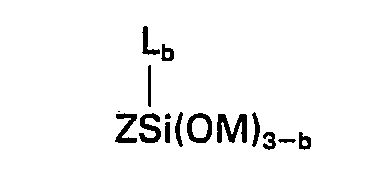
dans laquelle Z représente un groupe organique composé de carbone, d'hydrogène et d'oxygène renfermant au moins un groupe de la formule

L représente un groupe alkyle comptant 1 à 4 atomes de carbone inclusivement ou un groupe phényle, M représente un groupe alkyle ou alcoxyalkyle comptant moins de 6 atomes de carbone et la valeur de b est 0 ou 1, (D) et (E) étant employés en un rapport de 0,1 à 3 moles de (D) par mole de (E) et en un poids total de 0,88 à 4,5 parties en poids.
dans laquelle R représente un atome d'hydrogène, un groupe alkyle comptant 1 à 4 atomes de carbone inclusivement ou un groupe hydrocarboné aliphatique fixé à l'atome d'azote par une liaison de carbone à azote et contenant au moins un groupe amino, R' représente un groupe alkylène comptant 3 à 6 atomes de carbone inclusivement, X représente un groupe hydrocarboné monovalent comptant 1 à 6 atomes de carbone inclusivement, Y représente un groupe alkyle ou alcoxyalkyle comptant moins de 6 atomes de carbone et la valeur de a est 0 ou 1, et (E) un silane de la formule générale
dans laquelle Z représente un groupe organique composé de carbone, d'hydrogène et d'oxygène renfermant au moins un groupe de la formule
L représente un groupe alkyle comptant 1 à 4 atomes de carbone inclusivement ou un groupe phényle, M représente un groupe alkyle ou alcoxyalkyle comptant moins de 6 atomes de carbone et la valeur de b est 0 ou 1, (D) et (E) étant employés en un rapport de 0,1 à 3 moles de (D) par mole de (E) et en un poids total de 0,88 à 4,5 parties en poids.
2. Une composition telle que revendiquée dans la revendication 1, dans laquelle l'agent
de réticulation (B) est un sitane comportant 3 ou 4 groupes alcoxy fixés à l'atome
de silicium ou bien est un produit d'hydrolyse partielle et de condensation d'un tel
silane.
3. Une composition telle que revendiquée dans la revendication 1 ou la revendication
2, dans laquelle (C) est un sel d'étain ou d'organo-étain d'un acide carboxylique.
4. Une composition telle que revendiquée dans l'une quelconque des revendications
précédentes, dans laquelle (D) est un silane de la formule générale

dans laquelle R' représente un groupe alkylène comptant 3 ou 4 atomes de carbone et chaque Y représente un groupe méthyle, éthyle ou méthoxyéthyle.
dans laquelle R' représente un groupe alkylène comptant 3 ou 4 atomes de carbone et chaque Y représente un groupe méthyle, éthyle ou méthoxyéthyle.
5. Une composition telle que revendiquée dans l'une quelconque des revendications
précédentes, dans laquelle le silane (E) répond à la formule générale

dans laquelle M est un groupe méthyle ou éthyle.
dans laquelle M est un groupe méthyle ou éthyle.
6. Une composition telle que revendiquée dans l'une quelconque des revendications
précédentes, dans laquelle le rapport molaire de l'amino-silane (D) à l'époxy-silane
(E) se situe dans l'intervalle de 0,4:1 à 0,7:1.
7. Une composition telle que revendiquée dans l'une quelconque des revendications
précédentes, dans laquelle (D) et (E) sont employés en un poids total de 1,5 à 4,5
pour cent en poids par rapport au poids de (A).
8. Une composition telle que revendiquée dans l'une quelconque des revendications
précédentes, dans laquelle (D) et (E) one été mélanges ensemble avant d'être mélangés
avec les ingrédients restants de la composition.
9. Un procédé pour la préparation d'un élastomère, qui consiste à mélanger (A) 100
parties en poids d'un polydiorganosiloxane terminé par des groupes silanols, (B) 1
à 15 parties en poids d'un agent de réticulation de (A) qui est un composé silicié
dont la molécule comporte au moins trois groupes liés à du silicium choisis parmi
les groupes alcoxy et alcoxyalcoxy comptant moins de 6 atomes de carbone, (C) 0,1
à 10 parties en poids d'un sel métallique ou organométiallique d'un acide carboxylique,
(D) un silane de la formule générale
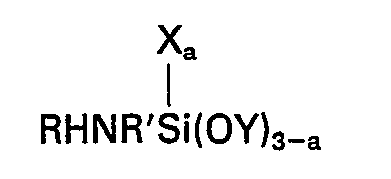
dans laquelle R représente un atome d'hydrogène, un groupe alkyle comptant 1 à 4 atomes de carbone inclusivement ou un groupe hydrocarboné aliphatique fixé à l'atome d'azote par une liaison de carbone à azote et contenant au moins un groupe amino, R' représente un groupe alkylène comptant 3 à 6 atomes de carbone inclusivement, X représente un groupe hydrocarboné monovalent comptant 1 à 6 atomes de carbone inclusivement, Y représente un groupe alkyle ou alcoxyalkyle comptant moins de 6 atomes de carbone et la valeur de a est 0 ou 1, et (E) un silane de la formule générale
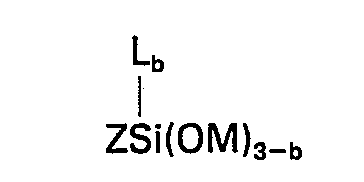
dans laquelle Z représente un groupe organique composé de carbone, d'hydrogène et d'oxygène renfermant au moins un groupe de la formule
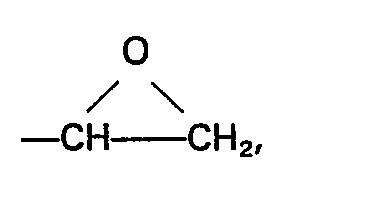
L représente un groupe alkyle comptant 1 à 4 atomes de carbone inclusivement ou un groupe phényle, M représente un groupe alkyle ou alcoxyalkyle comptant moins de 6 atomes de carbone et la valeur de b est 0 ou 1, (D) et (E) étant employés en un rapport de 0,1 à 3 moles de (D) par mole de (E) et en un poids total de 0,88 à 4,5 parties en poids, et à faire ensuite durcir la composition.
dans laquelle R représente un atome d'hydrogène, un groupe alkyle comptant 1 à 4 atomes de carbone inclusivement ou un groupe hydrocarboné aliphatique fixé à l'atome d'azote par une liaison de carbone à azote et contenant au moins un groupe amino, R' représente un groupe alkylène comptant 3 à 6 atomes de carbone inclusivement, X représente un groupe hydrocarboné monovalent comptant 1 à 6 atomes de carbone inclusivement, Y représente un groupe alkyle ou alcoxyalkyle comptant moins de 6 atomes de carbone et la valeur de a est 0 ou 1, et (E) un silane de la formule générale
dans laquelle Z représente un groupe organique composé de carbone, d'hydrogène et d'oxygène renfermant au moins un groupe de la formule
L représente un groupe alkyle comptant 1 à 4 atomes de carbone inclusivement ou un groupe phényle, M représente un groupe alkyle ou alcoxyalkyle comptant moins de 6 atomes de carbone et la valeur de b est 0 ou 1, (D) et (E) étant employés en un rapport de 0,1 à 3 moles de (D) par mole de (E) et en un poids total de 0,88 à 4,5 parties en poids, et à faire ensuite durcir la composition.
10. Un article comprenant un substrat portant le produit élastomère du procédé de
la revendication 9.
